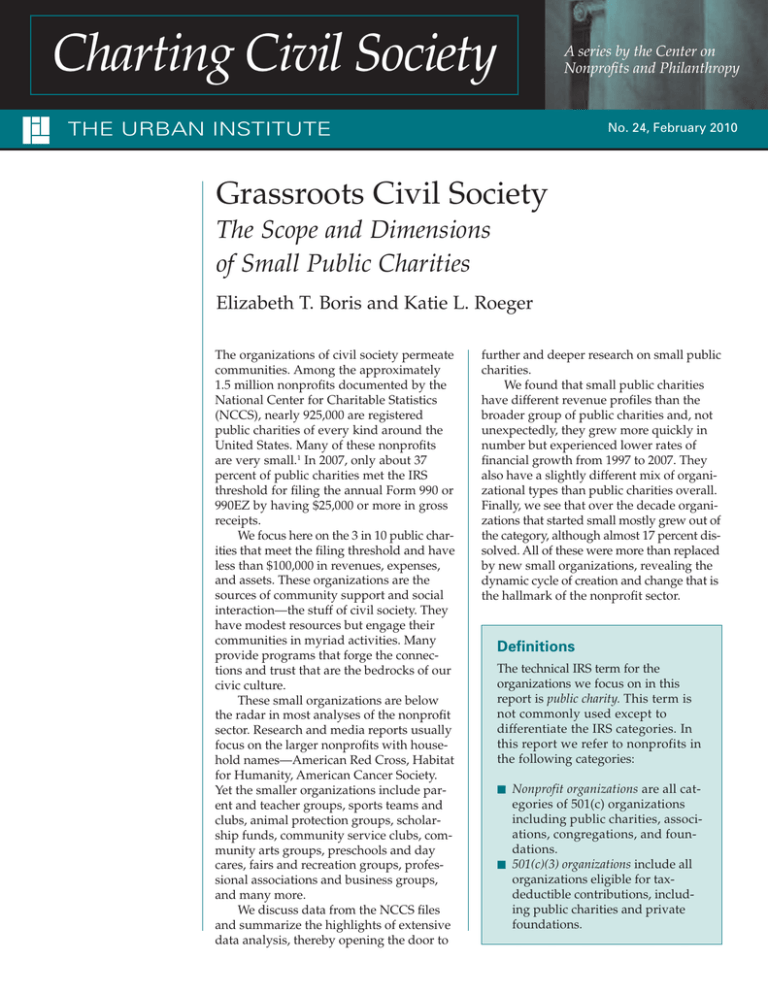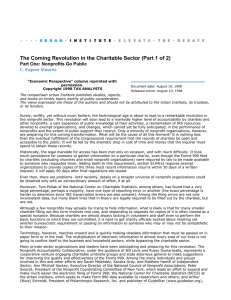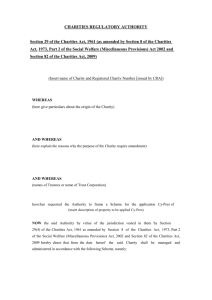
Charting Civil Society
A series by the Center on
Nonprofits and Philanthropy
THE URBAN INSTITUTE
No. 24, February 2010
Grassroots Civil Society
The Scope and Dimensions
of Small Public Charities
Elizabeth T. Boris and Katie L. Roeger
The organizations of civil society permeate
communities. Among the approximately
1.5 million nonprofits documented by the
National Center for Charitable Statistics
(NCCS), nearly 925,000 are registered
public charities of every kind around the
United States. Many of these nonprofits
are very small.1 In 2007, only about 37
percent of public charities met the IRS
threshold for filing the annual Form 990 or
990EZ by having $25,000 or more in gross
receipts.
We focus here on the 3 in 10 public charities that meet the filing threshold and have
less than $100,000 in revenues, expenses,
and assets. These organizations are the
sources of community support and social
interaction—the stuff of civil society. They
have modest resources but engage their
communities in myriad activities. Many
provide programs that forge the connections and trust that are the bedrocks of our
civic culture.
These small organizations are below
the radar in most analyses of the nonprofit
sector. Research and media reports usually
focus on the larger nonprofits with household names—American Red Cross, Habitat
for Humanity, American Cancer Society.
Yet the smaller organizations include parent and teacher groups, sports teams and
clubs, animal protection groups, scholarship funds, community service clubs, community arts groups, preschools and day
cares, fairs and recreation groups, professional associations and business groups,
and many more.
We discuss data from the NCCS files
and summarize the highlights of extensive
data analysis, thereby opening the door to
further and deeper research on small public
charities.
We found that small public charities
have different revenue profiles than the
broader group of public charities and, not
unexpectedly, they grew more quickly in
number but experienced lower rates of
financial growth from 1997 to 2007. They
also have a slightly different mix of organizational types than public charities overall.
Finally, we see that over the decade organizations that started small mostly grew out of
the category, although almost 17 percent dissolved. All of these were more than replaced
by new small organizations, revealing the
dynamic cycle of creation and change that is
the hallmark of the nonprofit sector.
Definitions
The technical IRS term for the
organizations we focus on in this
report is public charity. This term is
not commonly used except to
differentiate the IRS categories. In
this report we refer to nonprofits in
the following categories:
m
m
Nonprofit organizations are all categories of 501(c) organizations
including public charities, associations, congregations, and foundations.
501(c)(3) organizations include all
organizations eligible for taxdeductible contributions, including public charities and private
foundations.
A series by the Center on Nonprofits and Philanthropy
CHARTING CIVIL SOCIETY
m
m
m
m
m
the year 2000. In 1997, there were 63,493
organizations and in 2007 there were
104,536, an increase of almost 65 percent.
This compares to increases of 57 percent
among all reporting public charities and
59 percent of all the larger registered
public charities.
These small organizations represent
about 30 percent of reporting public charities, but they account for a minute proportion of the resources (less than 1 percent).
Public charities are 501(c)(3) organizations, excluding private foundations. They are tax exempt and
eligible to receive tax-deductible
contributions.
Registered public charities are public
charities that sought and obtained
tax-exempt status with the IRS.
990 N filers are the smallest public
charities required to register and
annually file Form 990-N with the
IRS because they have less than
$25,000 in gross receipts.
Reporting public charities are charities required to report annually to
the IRS on Form 990 or 990-EZ
because they have gross receipts
(revenues) of $25,000 or more.
Small public charities are the focus
of this report; they are reporting
public charities with $25,000 or
more in gross receipts and less
than $100,000 in each financial category, revenues, expenses, and
assets.
Types of Small Public Charities
Almost 30 percent of small public charities
are human services organizations, and
about a quarter are education related. The
arts make up the third largest category,
with about 13 percent. The proportion of
small public charities across the major
types—arts and culture, education,
environment and animals, health, human
services, inter-national and foreign affairs,
public and societal benefit, religionrelated, and others—has been relatively
unchanged over the past decade. The same
is true for all reporting public charities.
Although the proportions are similar, the
small public charities average a lower
percentage of health and human services
organizations and a higher percentage of
education and arts organizations than the
reporting sector as a whole. If we look at
all registered public charities, which include
Number of Small Public Charities
The number of small public charities has
grown steadily from 1997 to 2007, the latest
year for which IRS data are available; except
for a loss of about 2,000 organizations in
TABLE 1. Number of Public Charities by Year, 1997–2007
Year
Number of small
public charities
Number of reporting
public charities
Number of registered
public charities
1997
1998
1999
2000
2001
2002
2003
2004
2005
2006
2007
63,493
64,376
72,234
69,847
74,187
79,397
83,475
89,388
93,823
98,869
104,536
218,112
227,339
248,869
250,586
264,076
277,546
288,283
301,916
313,692
326,950
343,277
581,733
606,632
645,091
658,008
719,730
750,870
791,556
831,007
856,067
912,429
924,796
Source: The Urban Institute, National Center for Charitable Statistics, Core Files (Public Charities, 1997–2007); Internal Revenue
Service Business Master File, Exempt Organizations (1997–2008).
Notes: Small is defined as having less than $100,000 in total revenue, less than $100,000 in total assets, and less than $100,000 in
expenses. The number of small public charities is included in the total number of public charities reporting.
2
A series by the Center on Nonprofits and Philanthropy
CHARTING CIVIL SOCIETY
FIGURE 1. Percentage of Small Public Charities by Type, 2007
Religionrelated
7.8%
Public and
societal benefit
10.8%
Health
7.2%
Environment and
animal-related
4.8%
International and
foreign affairs
1.8%
Arts and
culture
13.1%
Other
0.5%
Human
services
29.3%
Education
24.7%
N = 104,536
Source: The Urban Institute, National Center for Charitable Statistics, Core Files (Public Charities, 2007).
the smallest organizations, there is a
similar consistency, but the proportion of
religious organizations is almost three
times as large in most years.
Over the 1997–2007 period, there has
been differential growth by types of organizations. Environmental organizations, for
example, grew by almost 109 percent at
one extreme, while health organizations
grew by only 38 percent. Religion-related
groups posted a strong growth rate at
almost 88 percent. The number of health
and human services groups increased more
slowly in the first half of the period and
accelerated in the second half, international
organizations did the reverse.
Finances
Small nonprofits represent less than
1 percent of the revenues, expenses, and
assets of all filing public charities. Although
their numbers increased from 1997 to 2007,
their revenues and expenses (in inflationadjusted dollars) increased at less than half
the pace of other reporting public charities.
However, there does not appear to be any
systematic difference between these rates
of growth.
In 2007, the 104,536 small public charities had $4.75 billion in revenues, $4.36 billion in expenses, and $2.93 billion in assets,
compared with 63,493 small public chari-
TABLE 2. Change in the Number of Small Public Charities by Organization Type, 1997–2007
Type of organization
Arts and culture
Education
Environment and animal-related
Health
Human services
International and foreign affairs
Public and societal benefit
Religion-related
Other
All small public charities
1997–2002
(%)
2002–2007
(%)
1997–2007
(%)
24.1
34.1
47.2
10.8
17.8
55.0
19.7
39.3
–18.6
26.3
32.2
41.8
24.7
33.1
25.0
29.9
34.8
196.9
56.7
77.3
108.6
38.1
56.8
93.8
55.4
87.9
141.7
25.0
31.7
64.6
Source: The Urban Institute, National Center for Charitable Statistics, Core Files (Public Charities, 1997–2007).
Note: All figures are in percents.
3
A series by the Center on Nonprofits and Philanthropy
CHARTING CIVIL SOCIETY
TABLE 3. Change in Number and Finances of Small Public Charities and Other Reporting Public Charities,
1997–2007
Small Public Charities
Year
1997–2002
2002–2007
1997–2007
Other Reporting Public Charities
Number
(%)
Total
revenue
(%)
Total
expenses
(%)
Total
assets
(%)
Number
(%)
Total
revenue
(%)
Total
expenses
(%)
Total
assets
(%)
25.0
31.7
64.6
9.9
13.9
25.2
11.2
12.4
25.0
15.8
13.9
31.9
28.2
20.5
54.4
14.6
33.6
53.1
22.4
23.3
51.0
12.0
36.5
52.8
Source: The Urban Institute, National Center for Charitable Statistics, Core Files (Public Charities, 1997–2007).
Notes: All figures are in percent. All financial amounts were converted to 2007 dollars before comparison.
ties in 1997 with $3.79 billion in revenues,
$3.49 billion in expenses, and $2.23 billion
in assets (in 2007 dollars). Between 1997 and
2007, revenues grew by 25 percent, expenses
by 25 percent, and assets by 32 percent. The
average organization in 1997, however, had
higher revenues, expenses, and assets than
in 2007. Compared to the finances of the
average reporting charity in 2007, which
had about $4 million in revenues, the small
nonprofits averaged $45,000, underlining
the modest resources available to these
organizations.
Sources of Revenue
Small public charities have very different
revenue patterns than the reporting
public charity sector as a whole. These
organizations are more likely to raise money
from members and community events
than from government sources. They are
much less reliant on fee-for-service
income (20 percent vs. 70 percent for
reporting public charities in 2007) and
much more reliant on contributions (more
than 50 percent vs. 20 percent of their
income in 2007). Government grants and
investment income are minor sources for
small public charities, but dues income
(8 percent) and other revenues (more than
16 percent) are more important for small
public charities than they are for the sector
as a whole. These patterns are remarkably
stable, with only a slight decline in fee-forservice and slight increase in private
contributions from 1997 to 2007.
Survival of Small Public Charities
Finally, we trace the creation and growth
patterns of small public charities. As table 6
TABLE 4. Finances of Small Public Charities by Year, 1997–2007
Year
Number
Total revenue
(in billions of
2007 dollars)
1997
1998
1999
2000
2001
2002
2003
2004
2005
2006
2007
63,493
64,376
72,234
69,847
74,187
79,397
83,475
89,388
93,823
98,869
104,536
3.79
3.82
4.16
3.92
4.01
4.17
4.27
4.47
4.55
4.64
4.75
Total expenses
(in billions
of 2007 dollars)
Total assets
(in billions of
2007 dollars)
3.49
3.49
3.79
3.55
3.68
3.88
4.00
4.17
4.21
4.27
4.36
2.23
2.27
2.46
2.40
2.47
2.58
2.62
2.72
2.78
2.85
2.93
Source: The Urban Institute, National Center for Charitable Statistics, Core Files (Public Charities, 1997–2007).
4
A series by the Center on Nonprofits and Philanthropy
CHARTING CIVIL SOCIETY
TABLE 5. Sources of Revenue for Small Public Charities by Year, 1997–2007
Year
Number
Total revenue
(in billions
of 2007 dollars)
1997
1998
1999
2000
2001
2002
2003
2004
2005
2006
2007
63,493
64,376
72,234
69,847
74,187
79,397
83,475
89,388
93,823
98,869
104,536
3.79
3.82
4.16
3.92
4.01
4.17
4.27
4.47
4.55
4.64
4.75
Percent of Total Revenue
Government
grants
Private
contributions
Fee-forservice
Investment
income
Dues
Other
revenue
3.5
2.8
2.6
2.6
2.6
3.3
3.0
2.6
2.3
2.1
1.7
46.2
47.2
48.0
48.4
49.3
49.7
49.8
50.4
51.0
52.1
52.7
23.5
23.0
22.5
22.0
21.5
21.5
21.5
21.3
21.2
20.7
20.3
1.6
1.6
1.5
1.5
1.2
0.1
0.0
0.2
0.4
0.5
0.7
8.4
8.4
8.4
8.4
8.2
8.2
8.2
8.2
8.0
7.9
7.9
16.8
17.0
17.0
17.1
17.1
17.2
17.4
17.3
17.1
16.8
16.8
Source: The Urban Institute, National Center for Charitable Statistics, Core Files (Public Charities, 1997–2007).
Notes: The value of government grants is an estimate. Fee-for-service includes revenue from both individuals and the government. Other revenue includes net income from special
events and activities, gross profit from sale of inventory, and other revenue.
FIGURE 2. Sources of Revenue for Small Public Charities and Other Reporting Public Charities, 2007
Small Public Charities
Other Reporting Public Charities
Fee-forservice
67.1%
Fee-forservice
20.3%
Private
contributions
52.7%
Other
revenue
16.8%
Dues
7.9%
Investment
income
0.7%
Government
grants
1.7%
N = 104,536
Private
contributions
14.2%
Dues
Investment
0.6%
income
7.9%
Government
grants
7.9%
Other
revenue
2.1%
N = 238,741
Source: The Urban Institute, National Center for Charitable Statistics, Core Files (Public Charities, 2007).
Notes: The value of government grants is an estimate. Fee-for-service includes revenue from both individuals and the government.
Other revenue includes net income from special events and activities, gross profit from sale of inventory, and other revenue.
Percentages may not sum to 100 because of rounding.
5
A series by the Center on Nonprofits and Philanthropy
CHARTING CIVIL SOCIETY
TABLE 6. Distribution of Public Charities by Size, 1997–2007
Size of organization
1997
1998
1999
2000
2001
2002
2003
2004
2005
2006
2007
Small
Newly registered and small
First time filing and small
Still small
Was large but now small
Total small organizations
0.9
5.4
21.8
1.1
29.1
0.9
3.6
22.7
1.1
28.3
1.0
3.7
23.1
1.1
29.0
1.2
3.9
21.5
1.2
27.9
1.1
3.9
21.7
1.3
28.1
1.2
3.9
22.0
1.5
28.6
1.0
3.7
22.8
1.5
29.0
1.1
4.1
22.9
1.4
29.6
1.0
3.9
23.6
1.4
29.9
1.1
3.8
23.9
1.4
30.2
1.1
4.3
23.6
1.4
30.5
Large
Was small but now large
Newly registered and large
First time filing and large
Still large
Total large organizations
2.5
0.9
3.9
63.7
70.9
2.8
1.0
2.9
65.0
71.7
2.7
1.0
3.0
64.3
71.0
2.9
1.0
2.8
65.5
72.1
2.6
0.9
3.0
65.3
71.9
2.6
1.0
2.9
64.9
71.4
2.4
0.8
2.7
65.2
71.0
2.5
0.8
2.7
64.5
70.4
2.5
0.7
2.5
64.4
70.1
2.6
0.7
2.5
63.9
69.8
2.8
0.8
2.6
63.3
69.5
Total organizations that filed
100.0
100.0
100.0
100.0
100.0
100.0
100.0
100.0
100.0
100.0
100.0
Source: The Urban Institute, National Center for Charitable Statistics, Core Files (Public Charities, 1997–2007).
Note: All figures are in percent. Percentages may not sum to totals shown because of rounding.
reveals, between 21 and 24 percent of
charities were small in every year of the
1997–2007 period and 63 to 66 percent of
charities were large in every year. Roughly
5 to 7 percent of the organizations were
new and small in any one year (almost
20,000 in 2007), and either they were newly
created and filed a Form 990 the same year
or they had been created earlier and first
reported to the IRS in a particular year. In
addition, between 3 and 5 percent were
new and large or newly reporting and large
(almost 13,000 in 2007). There were also
large charities that became small (1 to 1.5
percent per year) and small charities that
became large (2.4 to 2.9 percent per year).
If we consider the 63,493 organizations
that reported in 1997, we find that one year
later, only 81 percent still fall into the “small”
category. Each year the number diminishes
until, by 2007, there are only 21,500 of the
original group in the pool of small organizations. More than 18,100 of the originally
small organizations became larger by 2007.
Roughly 13,300 organizations fell below
the $25,000 filing threshold. Nearly 10,600
of the original group of small public charities did not survive the 10-year period. We
feel there is a need for additional investigation into the causes and outcomes of these
patterns.
The influx of new organizations and
turnover of old ones is a source of
dynamism. What is remarkable is that
6
with so many new organizations being
created each year the overall patterns are
so stable. This appearance of stability
invites research that delves more deeply
into finer categories of organizations and
regional analyses—topics that we will take
up in the future.
Note
1. Data on these very small organizations are available for the first time as a result of the Pension
Protection Act’s requirement that nonprofits with
revenues less than $25,000 file a new form, the
990-N, also known as E-postcard, annually. Katie
Roeger has drafted the first analysis of these data,
newly available to NCCS.
About the Authors
Elizabeth T. Boris, director of Urban
Institute’s Center on Nonprofits and
Philanthropy, is a national expert on the
charitable sector. She is also coeditor of
Nonprofits and Government: Collaboration and
Conflict (UI Press, 2006).
Katie L. Roeger is assistant director of the
National Center for Charitable Statistics
(NCCS), a program in the Center on Nonprofits and Philanthropy at the Urban
Institute. She manages the NCCS national
database on nonprofits and provides statistical support for surveys and other
research studies.
THE URBAN INSTITUTE
2100 M Street, NW
Washington, DC 20037
Nonprofit Org.
U.S. Postage
PAID
Permit No. 8098
Easton, MD
Address Service Requested
For more information, call
Public Affairs:
202-261-5709
or visit our web site,
http://www.urban.org.
To order additional copies
of this publication, call:
202-261-5687
or visit our online bookstore:
http://www.uipress.org.
The Urban Institute’s Center on Nonprofits and Philanthropy conducts research on
the nonprofit sector to inform decisionmakers in government, nonprofits, foundations,
and business. Our mission is to create an objective picture of the nonprofit sector,
advance transparency and accountability, and assess consequences of public policies on
the sector through rigorous research. We facilitate dialogue on pressing issues by hosting policy briefings and by disseminating findings widely. Our publications are available
on the Urban Institute web site, at http://cnp.urban.org.
Through the National Center for Charitable Statistics (NCCS), we create and maintain the National Nonprofit Data System, a research-quality data source on the nonprofit
sector. NCCS translates data on the sector’s size, scope, and financial trends into accessible information for local, state, and national policymakers and provides data and
technical assistance to scholars and the public. NCCS databases can be accessed at
http://www.nccs.urban.org.
The Urban Institute is a nonprofit, nonpartisan policy research and educational organization that examines the social, economic, and governance problems facing the nation.
The views expressed are those of the authors and should not be attributed to the Urban
Institute, its trustees, or its funders.
THE URBAN INSTITUTE
2100 M Street, NW
Washington, DC 20037
Copyright © 2010
Phone: 202-833-7200
Fax: 202-467-5775
E-mail: pubs@urban.org
Copyright © February 2010. The Urban Institute. All rights reserved. Permission is granted
for reproduction of this file, with attribution to the Urban Institute.





